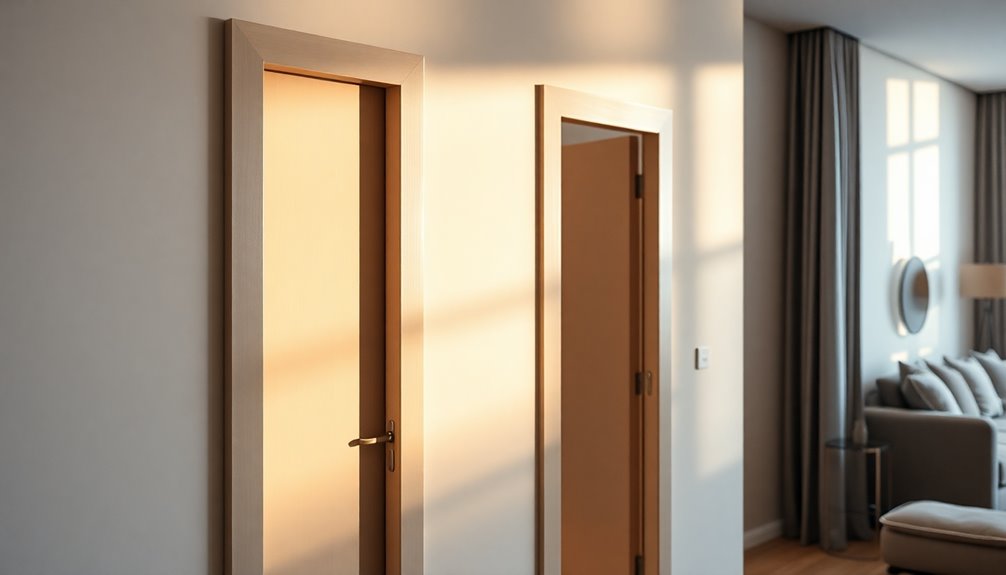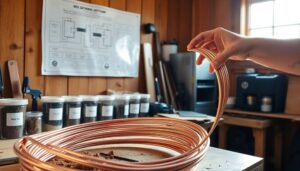You can soundproof pocket doors without breaking the bank by using some cost-effective strategies. Start with installing door sweeps to block gaps at the bottom, then seal edges with magnetic seals to minimize sound leakage. Consider applying Mass Loaded Vinyl (MLV) directly to the door for significant noise reduction. Regularly check and seal any cracks with acoustic caulk to enhance sound isolation. For a quick fix, use towels or fabric under the door. With a little creativity and some affordable materials, you'll improve your door's soundproofing. There's more tips ahead to help you achieve a quieter space.
Understanding Pocket Door Limitations
Understanding the limitations of pocket doors is essential if you're considering them for soundproofing purposes. While they offer a sleek design, pocket doors typically provide minimal sound insulation due to their construction.
Gaps at the bottom and around the edges allow sound transmission, considerably reducing their effectiveness in blocking noise. If you opt for hollow core pocket doors, be aware that they offer even less sound blockage compared to solid core options. A solid core door can achieve a higher sound transmission class (STC) rating, which is crucial for effective soundproofing. Additionally, monitoring savings and investments can help you allocate funds for necessary soundproofing upgrades.
Solid core pocket doors can enhance sound isolation, but they still require additional measures to tackle sound leakage effectively. The sound transmission class (STC) rating of pocket doors is generally lower than conventional doors, meaning they're less efficient in preventing sound from passing through.
To optimize their soundproofing capabilities, proper sealing of gaps and cracks is vital. Even small openings can dramatically diminish the performance of your pocket doors. Additionally, incorporating expense tracking tools can help manage costs associated with enhancing soundproofing measures.
If you're serious about soundproofing, consider the limitations of your chosen door type and be prepared to implement extra soundproofing solutions. By understanding these factors, you can make informed decisions that enhance your space's acoustic comfort.
Budget-Friendly Soundproofing Techniques
If you're looking to enhance soundproofing for your pocket doors without breaking the bank, several budget-friendly techniques can make a noticeable difference.
Start by installing door sweeps at the bottom of your doors to block sound from sneaking in through gaps. Pairing these with magnetic door seals around the edges can further minimize sound leakage, providing a tighter fit. Additionally, utilizing budgeting apps can help you effectively manage your finances while investing in soundproofing solutions. Effective management of spending allows you to allocate resources toward your home improvement projects.
Consider using soundproof curtains with verified STC ratings; they add an extra layer of sound blocking and can greatly reduce noise intrusion from adjacent rooms.
If you're in need of a quick, inexpensive solution, simple DIY methods like placing towels or fabric under the door can temporarily help minimize sound transmission.
Don't overlook the importance of regularly checking for and sealing any cracks or gaps in the door frame and walls. This small task can greatly improve sound isolation for your pocket doors without the need for costly renovations. Additionally, implementing a budget app like YNAB can help you allocate funds for soundproofing materials effectively.
Essential Tools for Soundproofing
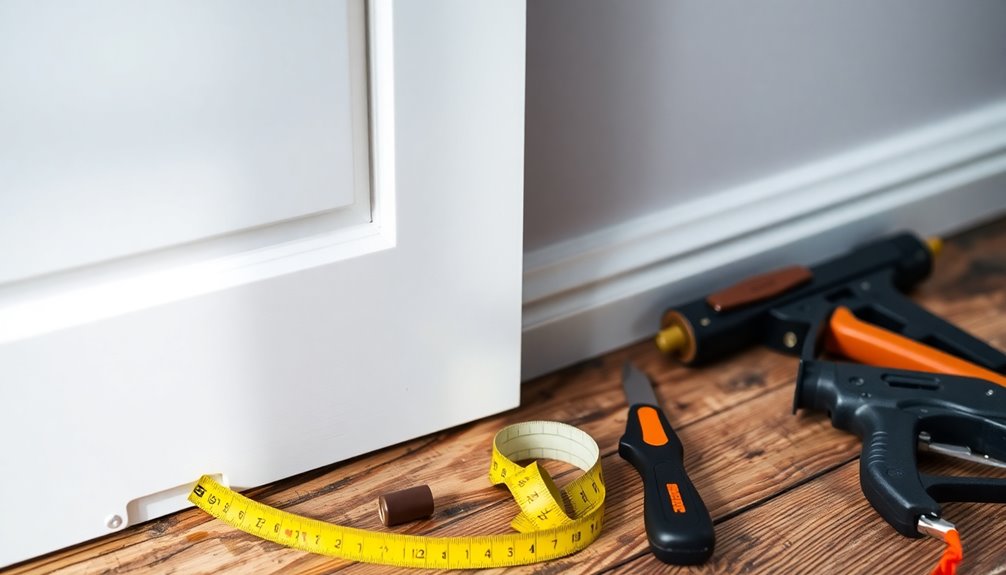
After implementing budget-friendly soundproofing techniques, you're ready to gather the right tools to take your pocket door soundproofing to the next level.
First on your list should be mass loaded vinyl (MLV). This heavy material adheres directly to your door, providing an effective barrier against sound. Additionally, consider using automated processes to streamline the installation of your soundproofing materials. Understanding the importance of measuring performance metrics can also ensure that you choose the most effective materials for your project.
Next, invest in door sweeps and seals. These are critical for sealing gaps at the bottom and around the edges of your door, preventing sound leakage.
You'll also need acoustic caulk, which is perfect for filling any cracks or gaps around the door frame, further enhancing soundproofing.
A utility knife is essential for cutting the MLV and other materials to the right size. This guarantees a precise fit, maximizing sound insulation.
To avoid waste and guarantee accuracy, don't forget your measuring tape. This tool helps you measure the dimensions of both the door and the materials you'll use, allowing for effective installation.
Additionally, consider utilizing coupon codes to save on your soundproofing materials, making your project even more budget-friendly.
With these tools in hand, you'll be well-equipped to tackle your pocket door soundproofing project efficiently and effectively.
Get ready to enjoy a quieter space!
Applying Acoustic Sealants Effectively
When it comes to applying acoustic sealants, selecting the right type is essential for effective soundproofing. You'll want to focus on sealants with a high Sound Transmission Class (STC) rating and use proper application techniques to guarantee a tight seal around your pocket doors. Additionally, employing budgeting apps can help you manage expenses related to home improvement projects effectively. Using these tools can enhance your financial control, ensuring that you stay within budget while investing in quality materials. Many of these tools also provide financial literacy resources that can aid in making informed spending decisions.
Selecting Appropriate Sealants
Choosing the right acoustic sealants is vital for effective soundproofing around pocket doors. These specialized sealants are designed to remain flexible after curing, which helps them fill gaps and cracks effectively.
When selecting your sealant, look for products with a high Sound Transmission Class (STC) rating—ideally above 50. A higher STC rating indicates better performance in blocking sound transmission, ensuring a quieter environment.
Before applying, make sure the surfaces are clean and dry for best adhesion. Use a caulking gun to create a continuous bead of sealant along the door frame and any visible gaps. This step is important for minimizing sound leakage.
For maximum soundproofing, consider combining your acoustic sealants with door sweeps and weatherstripping. This combination will seal the bottom and sides of your pocket doors, further reducing sound transmission.
Finally, remember that sealants can degrade over time. To maintain your soundproofing effectiveness, regularly inspect and reapply sealants as needed.
Application Techniques for Seals
Properly applying acoustic sealants around your pocket doors can make a notable difference in soundproofing effectiveness. To achieve a truly soundproof room, you need to verify that all gaps and cracks around the door frame are completely filled.
Even small openings can compromise your efforts, so attention to detail is essential.
Here are a few tips to effectively apply acoustic sealants:
- Use closed-cell foam or acoustic caulk: These materials create a tight seal and minimize sound leakage around the door's perimeter.
- Install double rubber sweep weatherstripping: Placing this at the gap at the bottom of the pocket door considerably reduces sound transmission.
- Apply in layers: To guarantee a solid barrier against noise, apply the sealants in layers, allowing for proper drying time between applications.
Don't forget to regularly inspect and maintain your seals. Any wear or damage should be addressed promptly to keep your soundproofing efforts effective.
With these application techniques, you'll enhance the acoustic performance of your pocket doors and enjoy a quieter space.
Utilizing Mass Loaded Vinyl
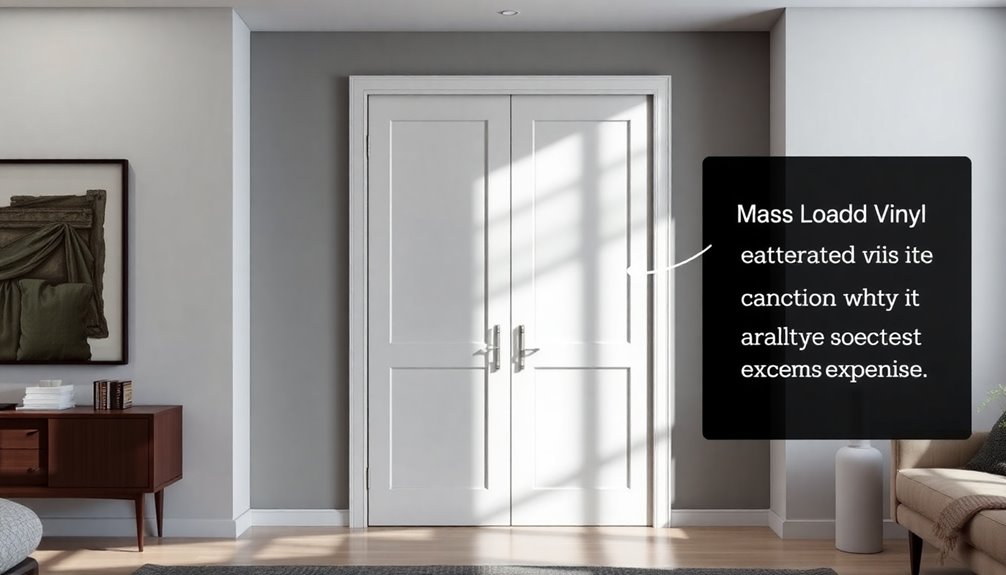
Mass Loaded Vinyl (MLV) is a game-changer for soundproofing your pocket doors, offering a dense yet flexible solution that greatly reduces noise transmission. Installing MLV is straightforward; just apply it directly to the door's surface and seal any gaps with acoustic caulk for best performance. This cost-effective option not only enhances your existing doors but also keeps your space quieter and more comfortable. Additionally, using sustainable materials like MLV supports eco-friendly practices by minimizing waste and reducing your overall carbon footprint. Choosing materials that are part of a circular economy helps promote sustainability in home improvement projects. By opting for products from ethical brands, you contribute to a more sustainable future while investing in quality home improvements.
Material Benefits Overview
Often overlooked, Mass Loaded Vinyl (MLV) stands out as a top choice for soundproofing pocket doors due to its effectiveness and ease of application. This dense yet flexible material can greatly enhance sound isolation, providing an impressive STC rating that improves performance by 30-40%.
When you apply MLV to existing pocket doors, you'll find it helps seal common gaps and cracks where sound typically leaks, ensuring a quieter environment.
Here are some key benefits of using MLV for your soundproofing project:
- Cost-effective: MLV is budget-friendly compared to other soundproofing solutions, allowing you to achieve better sound isolation without overspending.
- Easy installation: You can easily apply MLV to your existing pocket doors without extensive renovations or replacements, making it a practical choice.
- Enhanced effectiveness: When combined with door sweeps and seals, MLV creates a thorough soundproofing solution that maximizes performance.
Installation Process Simplified
Installing Mass Loaded Vinyl (MLV) on pocket doors can markedly enhance soundproofing with just a few straightforward steps.
Start by measuring your door dimensions accurately so you can cut the MLV to the right size for effective sound blocking. Once you have your pieces ready, make sure the surface of the pocket door is clean and dry. Use an adhesive or double-sided tape to firmly secure the MLV, ensuring it adheres well for ideal sound blockage.
After applying the MLV, seal the edges with acoustic caulk to prevent any sound leakage through gaps. This step is vital for maintaining the effectiveness of your soundproofing efforts.
To further minimize sound transmission, consider incorporating door sweeps and magnetic perimeter seals at the bottom and around the edges of the door.
Finally, regularly check your installation for any wear and tear. Maintaining the integrity of your soundproofing materials is essential for long-lasting noise reduction performance.
Enhancing Soundproofing With Door Sweeps
Enhancing soundproofing in your home can be as simple as adding door sweeps to your pocket doors. These handy additions can dramatically reduce sound leakage by sealing the gap between the door and the floor, making your space quieter and more private.
Here are some key benefits of installing door sweeps:
- Cost-effective: Door sweeps are generally inexpensive compared to other soundproofing methods.
- Easy installation: You can quickly install them yourself, guaranteeing a snug fit that maximizes noise reduction.
- Variety of options: Choose from standard rubber or vinyl sweeps, or opt for automatic models that provide a tighter seal.
Proper installation is essential to guarantee the sweeps make contact with the floor and are aligned correctly. This will maximize their sound-blocking capabilities and minimize unwanted noise.
Evaluating Soundproofing Products
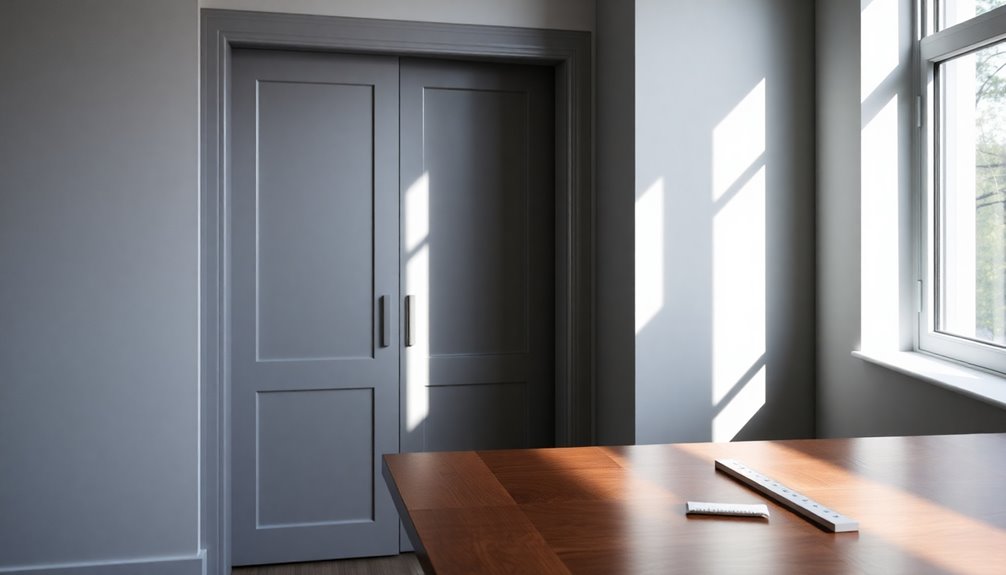
When you're looking to improve the soundproofing of your pocket doors, knowing how to evaluate soundproofing products is vital.
Start by checking for proven Sound Transmission Class (STC) ratings. Products like AcoustiDoor can block noise by up to 38 dB, making them effective choices.
Mass loaded vinyl (MLV) is another budget-friendly option worth considering. You can apply it directly to your pocket doors to enhance soundproofing without needing a full door replacement.
Don't forget about the importance of sealing gaps around your door frame. Magnetic perimeter seals can greatly boost soundproofing performance by minimizing sound leakage, which is important for maintaining a quiet environment.
Additionally, consider Acoustical curtains, like AcousticCurtain™, as a cost-effective alternative. They not only block outside noise but also allow natural light to filter through, adding functionality to your space.
Lastly, remember that utilizing door sweeps alongside these soundproofing materials can enhance overall effectiveness.
By addressing gaps at the bottom of pocket doors, you'll create a more thorough sound isolation solution.
With these strategies, you can effectively evaluate and select the right products for your soundproofing needs.
Creative DIY Solutions for Soundproofing
One of the most effective and budget-friendly ways to soundproof pocket doors is by getting creative with DIY solutions. You don't need to spend a fortune; simple materials can make a significant difference.
Here are three practical options to take into account:
- Door Sweeps: Install door sweeps at the bottom of your pocket doors to seal gaps, preventing sound leakage.
- Acoustic Caulk: Use acoustic caulk to fill in any cracks or gaps around the door frame. This helps improve sound isolation and stops noise from seeping through.
- Soundproof Curtains: Hang soundproof curtains in front of the pocket doors. They provide an extra layer of sound dampening while still allowing for easy access when needed.
Additionally, if you're looking for temporary fixes, placing towels or blankets under the door can help minimize sound transmission until you implement more permanent measures.
Conclusion
Now that you've explored budget-friendly soundproofing techniques for your pocket doors, imagine the peace you'll create in your space. Picture the quiet moments where outside noise fades away, leaving only tranquility behind. With the right tools and a bit of creativity, you're just steps away from transforming your environment. Don't underestimate the power of a well-sealed door; your sanctuary awaits. Ready to plunge in and start your soundproofing project? The results might just surprise you!

